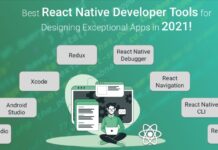The rate of adoption of mobile health apps for healthcare is increasing by leaps and leaps and An analysis of the market for healthcare research report released by the renowned site Grand View Research says that “The market value of the market for mHealth apps worldwide was estimated at USD 38.2 billion as of 2021. It is expected to grow by a CAGR of 11.8 percent from 2022 until 2030.”
Naturally, healthcare app development has evolved into an investment opportunity that is lucrative. But the process of creating an app for healthcare isn’t a easy task and comes with difficulties, complexity and expensive development costs. If you don’t want to wind with costly errors You must ensure that you execute the entire development process in a flawless manner and use the correct method. This article will go over the best strategies in the creation and development of an app for healthcare. Explore the essential elements of developing a medical app and discover how to choose the most effective approach to achieve the success you want.
However, before we go into the depths, let’s examine the structure of an mobile health application!
Designing and Developing a Healthcare App: Key Strategies
App Ideation
The process is comprised of three important steps. The first step is to do a thorough analysis of the health applications available on the market. This will enable you gain insights specific to your industry and determine the trends currently most popular among users of medical apps. Additionally, you’ll be in a position to identify the problem areas in the health sector which your app could solve.
After that, you should select the right niche. Who is your intended user? Also, determine “What issues can your app address?”. Finally, look at your competitors to determine what they are good at, their weaknesses and the benefits they’ve added through their apps as well as the areas in which they’ve fallen short of impressing. You’re now in a position to determine what issue your app could overcome, what strategy you need to take to deliver the best solution and also how you can distinguish yourself from the rest of your competition.
Identifying the Needs of the Target Audience
Your app will be recognized when it has user-driven functions. The second step to take is determine the primary goals of your app and establish precise goals. In order to do this, research your intended audience and determine their needs and preferences. To achieve this it is possible to interview your intended audience and conduct surveys to discover the root causes of issues that healthcare app users face. In this instance, you must question your audience about their expectations from a health app, their preferences in regards to healthcare consultation, the issues they face with existing apps and more.
When you are defining your app’s purpose You must be aware of accessibility and engagement. It is also important to consider other factors like location and the demographics of your target audience. If, for instance, your app is targeted towards an elderly group, you might want to look at larger buttons, fonts and a simple UX flow. If your app is targeted at young people or children it is possible to incorporate game-like elements or games to make them more engaged. However gaming is not needed by apps intended for medical professionals.
Selection of the App Type & Relevant Resources
App Type
Next, narrow down your focus to the kind of application for healthcare that you’d like to develop. Check out the most common kinds of medical applications.
- Telehealth & Remote Monitoring applications allow patients to take advantage of the convenience of remote doctor consultation and treatment. They use wearables that are able to generate and transmit patient information such as ECG watching, lifescan reports and Oxygen-level tests, among others.
- Clinical assistance applications assist doctors in diagnosing medical conditions and treatments. These apps offer EHR and EMR access and include features such as the ability to check for symptoms, taking images, and even reviewing patient charts and laboratory results.
- Appointment Scheduling apps and reminder apps help administrators make appointments online and then send automated reminders by messages sent via push to the patients and physicians.
- Fitness and Lifestyle Apps as well as apps to engage patients aid users to maintain their health, keeping track of their fitness routine as well as managing chronic ailments and more.
- Informational Health Services Apps that relate to Medical Education & Resources include medical reference guides, study guides, clinical studies and information on drugs and medical research, etc.
Resources
A healthcare application’s code must be perfect. So, you need to recruit experts who are experienced and have experience in the field. Additionally developing healthcare apps, you’ll require diverse resources such as front-end developers, UI/UX designers as well as back-end developers Product managers, project managers and many more.
This is why outsourcing development work to a seasoned healthcare development firm is the best option. This is because these companies possess the appropriate experience, are able to navigate every obstacle that comes up during the process of development, and are aware of the healthcare app regulatory requirements like HIPAA. Furthermore, a reliable healthcare development company provides complete healthcare app development solutions right beginning with the ideation stage and support after deployment phase.
Selecting the devices and Platforms your app will support
It is essential to select the right operating system and device that the app for healthcare will work with. In this case, you have two choices. Create a native application designed for users on the Android as well as the iOS platform or go with the development of cross-platform apps. The choice of platform is based on the platforms that your users are most likely to utilize. The cross-platform approach is effective in increasing customer reach and enhancing native development with regards to security of apps. Therefore, the strategy you choose to take will depend on your needs and your business goals.
For devices that support mobile phones, tablets, as well as wearable devices is recommended when developing the mobile application for healthcare. Users with these types of devices are able to access your app immediately and quickly. However desktop computers such as computers and laptops are most often used by older users and those who are engaged in medical research and training.
Picking the Suitable Tech Stack, Technologies, & Feature Set
Tech Stack
Choose the best combination of back-end frameworks and front-end frameworks and programming languages for the development of your health app. The most commonly used front-end frameworks are React, Vue, Angular and others. Back-end frameworks include Laravel, Node.js, Ruby on Rails and others. and mobile app development frameworks include React Native, Flutter, Ionic and many more. Amongst programming languages; Swift, Kotlin, PHP, Node.JS, etc. are the most well-known ones. Also, you need IDEs such as Android Studio & Xcode; databases like MongoDB, MySQL, PostgreSQL, Redis, etc. A cloud storage platform such as Amazon S3; and app deployment platforms such as Native Android, Native iOS, Cloud, SaaS, and more.
Technologies
Technologies allow you to build the features you want to your app for medical use. Explore the latest technology for developing apps for healthcare.
IoT and Wearable devices: This technology is extensively used in the field of healthcare to monitor vital signs of the body that aid in the treatment of chronic illnesses. Wearables powered by IoT, like smartwatches and wearables with sensors. can be used to track individuals’ health indicators like temperature and blood pressure, blood sugar levels, sleep patterns eating habits, exercise and numerous other parameters. These data are collected via wearables, and is then transmitted to doctors through apps. In this way, doctors are able to track the progress of patients and recommend treatment plans without having patients visit the clinic each time to check-up.
Blockchain Blockchain technology has the potential to secure healthcare data from breaches in security and increase the quality and transparency that medical information. Solutions using Blockchain reduce the centralization of the network that is involved in healthcare data exchange and transactions between healthcare providers, patients and insurance companies. A Blockchain-based network tracks every transaction and automatically detects irregularity or conflicting information, which makes it secure against hacking. Here’s an example of how data is transferred within the Blockchain network.
Artificial Intelligence Most common types of AI application in the field of healthcare are virtual medical assistant and chatbots. Chatbots can serve a range of functions, including diagnostic tools and Customer service reps. AI is also utilized in tasks such as drug discovery as well as health imaging, genomics and precision medicine. In addition, AI algorithms work wonders in reducing the development process in the pharmaceutical industry.
Machine Learning and Deep Learning: Machine Learning plays an essential role in detecting cancer in the beginning stages. It is able to analyze medical images by separating things like lesions and classifying them into normal and abnormal kinds. The facial recognition technology based on ML used in medical apps aids in the treatment of patients with Parkinson’s and Asperger’s disease. ML coupled along with Deep Learning has led to the development of the revolutionary “Computer visual.”
In addition to the ones mentioned advanced technologies such as AR VR, VR, and Metaverse are being looked at as possible healthcare apps. Virtual Reality is being used for treating conditions associated with anxiety, stroke post-traumatic stress, autism in children, and so on. VR simulations are believed to improve the skills of doctors and assist them in planning complex operations. Metaverse is being studied as a surgical simulation, treatment that are related to rehabilitation, etc.
Feature Set
The features of the mobile application for healthcare must be determined in accordance with the nature and nature of the app as well as the function it will serve. The primary features for healthcare apps are registration and login for users, physician profile, virtual waiting rooms and symptom checker, appointment scheduler, reminders/push messages, calendar integration prescription tracking, e-prescription generation and real-time audio/video consultation. monitoring of patient progress and integration with third party providers with messaging, geo-location, the patient community, cross-platform accessibility offline mode for certain features, etc. The features like charting, reports and analytics assist doctors and healthcare providers perform their duties effectively.
UI/UX Designing
When the process of making decisions is complete, it’s time to start designing the app. Keep in mind that the UX/UI design of an app for healthcare should be flawless without issues. To achieve this it is essential to follow guidelines.
Be aware of the issues associated with medical apps from the user’s perspective and concentrate on developing an easy and uniform design. Your app should run smoothly and help users carry the next step to allow users to get to the desired destination without fuss. The design of your app should be clean and user-friendly with less “interaction factors.” Users are able to navigate to every important screen with just the click of a button. Also, stay clear of the design of your app that makes users to navigate through multiple unneeded screens.
It’s also a good idea to tailor your app’s style to meet the needs of specific groups of users. For instance an app catering to those who have hearing impairments must display captions even when the patient calls the doctor. Apps for people suffering from motion sickness must have minimal animations. Options like voice input, or the possibility to convert text to speech are recommended in apps designed for patients who suffer from body pain.
Create content that gives details about the application. It can help users easily interact with the application. Things like menu labels and buttons, terms and conditions of use, instructions as well as error message are crucial elements to include in UX writing. It is recommended to present important information in the first stages of the user’s journey, and to reduce cognitive burden as much as you can.
App Prototyping
Prototyping apps is an essential process during the designing phase. It is the process of making an early prototype of the product you want to create. It’s used to test the feature’s potential to perform as expected. The app prototype is created by incorporating features in clickable screens that appear like the actual product. A prototype app can function as an actual application on smartphones’ screens. This makes it useful to test A/B for users’ screens. It is also possible to verify that all functions of the app work in line with the platform you’ve chosen. There are a variety of tools for prototyping available on the marketplace like Draftium, Marvel, InVision, Adobe XD, Axure, Origami, Atomic, Sketch and more.
Development
This is the most important step which is actually the development process. The most tested and tried strategy for this phase is to use an agile development method. This approach requires breaking the process of development into smaller segments. Small-sized sprints let you continually provide and to test. Testing of previous sprints as well as the creation of the following sprint can be conducted simultaneously , without interfering the other. This method of agile development also permits you to keep track of the whole extent of the project and determine what adjustments are required in the coming sprints.
Apps for healthcare must be integrated with existing systems, such as EHR and EMR as well as other devices for healthcare and applications in the medical facilities to facilitate the seamless exchange of data between the two. Apps are developed to interface with these systems and devices by using APIs.
Implementing Security Measures & HIPAA Compliance
Security and privacy are essential to medical apps since they deal with sensitive patient data. Additionally, medical apps are particularly susceptible to cyber-security threats. Thus, app developers need to be extra vigilant about implementing the appropriate security measures and complying with the regulations. All governments around the globe have enforced strict laws and regulations that protect the privacy of data from patients. For example that all healthcare applications in the US which handle PHI have to comply with HIPAA (Health insurance Portability and Accountability Act) in compliance Apps in the European Union need to follow GDPR (General Data Protection Regulations) and medical applications in Canada should comply with PIPEDA (Personal Privacy and Electronic Documents Act).
So, after your app has been developed, it is essential to take security measures. The most common security methods include installing and activating encryption from end-to-end on smartphones devices, restricting access to the device, and using authentication methods such as passwords for users that are strong and multi-factor authentication. to protect against hackers from gaining access to your data and committing cyber-attacks. Also, make sure to update your app regularly to prevent network attacks that could damage the data of your healthcare app and adhere to an expiration policy for your app (the app expires automatically after the pre-determined time).
Also, be sure to review the privacy policies as well as specific rules for mobile applications for healthcare as defined in Apple’s App Store as well as Google’s Play Store.
Quality Assurance Phase
The process of testing and debugging is initiated during the development stage because every problem has been identified, and addressed in a single step. Also, you must perform quality assurance tests to eliminate any potential blind spots and to improve the performance of your app.
Product Deployment & Maintenance
Your healthcare app is ready to be released on either the App Store (iOS) or Play Store (Android), or both (if the app is compatible with the two platforms iOS as well as Android). When you deploy your app, it is important be sure that the rules for the stores aren’t in violation.
After the app has been released, it will require constant monitoring and support since glitches and issues with technology may occur at any time. Also, you must regularly update the app and include the features you need to keep up with current trends.
Concluding Lines:
I hope that the information provided in this article will help you understand the essentials of healthcare application development as well as the most effective methods and strategies to use when designing healthcare applications. In short your mobile application for healthcare must provide accurate results and provide security that is military-grade handling sensitive patient information. If you do not offer accuracy and safety for data then you’re at risk of being in trouble and could be affected by legal penalties.
So, be sure to select the right type of resources capable of handling the complexities of developing healthcare apps and requirements, as well as Third-party integrations and regulatory requirements and so on. healthcare app designers with a wealth of knowledge, experience and innovative abilities are essential in this regard. Don’t forget to create your app HIPAA secure and follow additional security procedures in addition.















